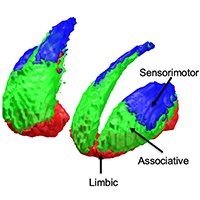Striatal topographical organization: Bridging the gap between molecules, connectivity and behavior

Accepted: 7 September 2021
HTML: 16
All claims expressed in this article are solely those of the authors and do not necessarily represent those of their affiliated organizations, or those of the publisher, the editors and the reviewers. Any product that may be evaluated in this article or claim that may be made by its manufacturer is not guaranteed or endorsed by the publisher.
Authors
The striatum represents the major hub of the basal ganglia, receiving projections from the entire cerebral cortex and it is assumed to play a key role in a wide array of complex behavioral tasks. Despite being extensively investigated during the last decades, the topographical organization of the striatum is not well understood yet. Ongoing efforts in neuroscience are focused on analyzing striatal anatomy at different spatial scales, to understand how structure relates to function and how derangements of this organization are involved in various neuropsychiatric diseases. While being subdivided at the macroscale level into dorsal and ventral divisions, at a mesoscale level the striatum represents an anatomical continuum sharing the same cellular makeup. At the same time, it is now increasingly ascertained that different striatal compartments show subtle histochemical differences, and their neurons exhibit peculiar patterns of gene expression, supporting functional diversity across the whole basal ganglia circuitry. Such diversity is further supported by afferent connections which are heterogenous both anatomically, as they originate from distributed cortical areas and subcortical structures, and biochemically, as they involve a variety of neurotransmitters. Specifically, the cortico-striatal projection system is topographically organized delineating a functional organization which is maintained throughout the basal ganglia, subserving motor, cognitive and affective behavioral functions. While such functional heterogeneity has been firstly conceptualized as a tripartite organization, with sharply defined limbic, associative and sensorimotor territories within the striatum, it has been proposed that such territories are more likely to fade into one another, delineating a gradient-like organization along medio-lateral and ventro-dorsal axes. However, the molecular and cellular underpinnings of such organization are less understood, and their relations to behavior remains an open question, especially in humans. In this review we aimed at summarizing the available knowledge on striatal organization, especially focusing on how it links structure to function and its alterations in neuropsychiatric diseases. We examined studies conducted on different species, covering a wide array of different methodologies: from tract-tracing and immunohistochemistry to neuroimaging and transcriptomic experiments, aimed at bridging the gap between macroscopic and molecular levels.
How to Cite

This work is licensed under a Creative Commons Attribution-NonCommercial 4.0 International License.
PAGEPress has chosen to apply the Creative Commons Attribution NonCommercial 4.0 International License (CC BY-NC 4.0) to all manuscripts to be published.
Similar Articles
- Yuan Cao, Dong-Hui Ao, Chao Ma, Wen-Ying Qiu, Yi-Cheng Zhu, Immunoreactivity and a new staining method of monocarboxylate transporter 1 located in endothelial cells of cerebral vessels of human brain in distinguishing cerebral venules from arterioles , European Journal of Histochemistry: Vol. 65 No. s1 (2021): Special Collection on Advances in Neuromorphology in Health and Disease
- Cristian Turato, Mariapia Vairetti, Marta Cagna, Alessandra Biasiolo, Andrea Ferrigno, Santina Quarta, Mariagrazia Ruvoletto, Silvia De Siervi, Patrizia Pontisso, Laura Giuseppina Di Pasqua, SerpinB3 administration protects liver against ischemia-reperfusion injury , European Journal of Histochemistry: Vol. 66 No. 4 (2022)
- T. Petr, V. Å mÃd, J. Å mÃdová, H. Hůlková, M. Jirkovská, M. Elleder, L. Muchová, L. Vitek, F. Å mÃd, Histochemical detection of GM1 ganglioside using cholera toxin-B subunit. Evaluation of critical factors optimal for in situ detection with special emphasis to acetone pre-extraction , European Journal of Histochemistry: Vol. 54 No. 2 (2010)
- V. Nicolin, F. Dal Piaz, S. L. Nori, P. Narducci, N. De Tommasi, Inhibition of bone resorption by Tanshinone VI isolated from Salvia miltiorrhiza Bunge , European Journal of Histochemistry: Vol. 54 No. 2 (2010)
- Mariailaria Verderame, Ermelinda Limatola, Rosaria Scudiero, Metallothionein expression and synthesis in the testis of the lizard Podarcis sicula under natural conditions and following estrogenic exposure , European Journal of Histochemistry: Vol. 61 No. 2 (2017)
- Wenxue Huang, Wei Li, Juan Liu, Jianxia Hou, Huanxin Meng, Ferritin expression in the periodontal tissues of primates , European Journal of Histochemistry: Vol. 63 No. 3 (2019)
- Zhao Zhang, Hongming Fan, William Richardson, Bruce Z. Gao, Tong Ye, Management of autofluorescence in formaldehyde-fixed myocardium: choosing the right treatment , European Journal of Histochemistry: Vol. 67 No. 4 (2023)
- E Bronzetti, M Artico, I Kovacs, LM Felici, Expression of neurotransmitters and neurotrophins in neurogenic inflammation of the rat retina , European Journal of Histochemistry: Vol. 51 No. 4 (2007)
- A. Arcucci, M.R. Ruocco, F. Albano, G. Granato, V. Romano, G. Corso, C. Bancone, E. De Vendittis, A. Della Corte, S. Montagnani, Analysis of extracellular superoxide dismutase and Akt in ascending aortic aneurysm with tricuspid or bicuspid aortic valve , European Journal of Histochemistry: Vol. 58 No. 3 (2014)
- F. Dorko, J. Danko, S. Flešárová, E. Boroš, A. Sobeková, Effect of pesticide bendiocarbamate on distribution of acetylcholine- and butyrylcholine-positive nerves in rabbit’s thymus , European Journal of Histochemistry: Vol. 55 No. 4 (2011)
<< < 15 16 17 18 19 20 21 22 > >>
You may also start an advanced similarity search for this article.

 https://doi.org/10.4081/ejh.2021.3284
https://doi.org/10.4081/ejh.2021.3284










